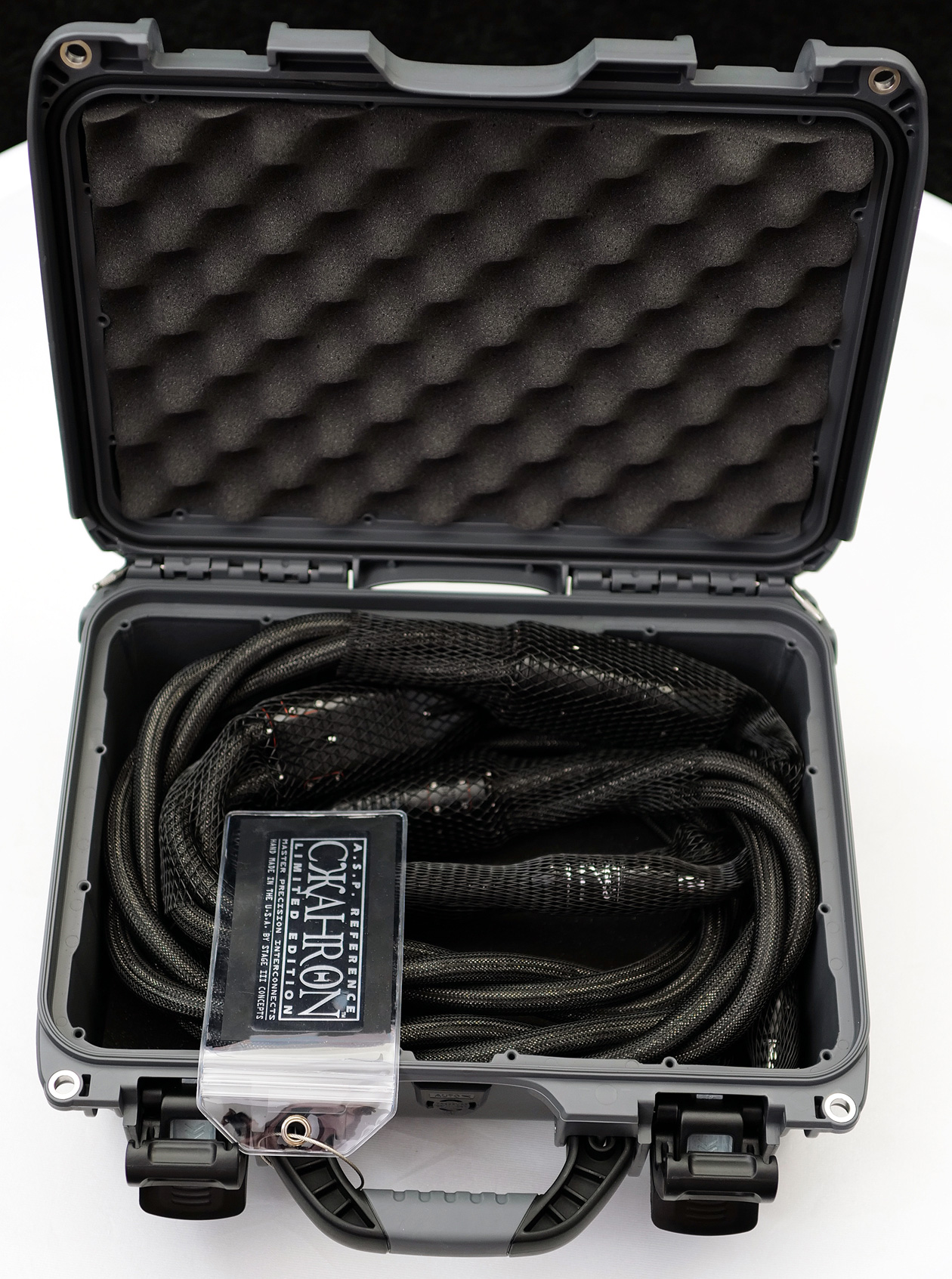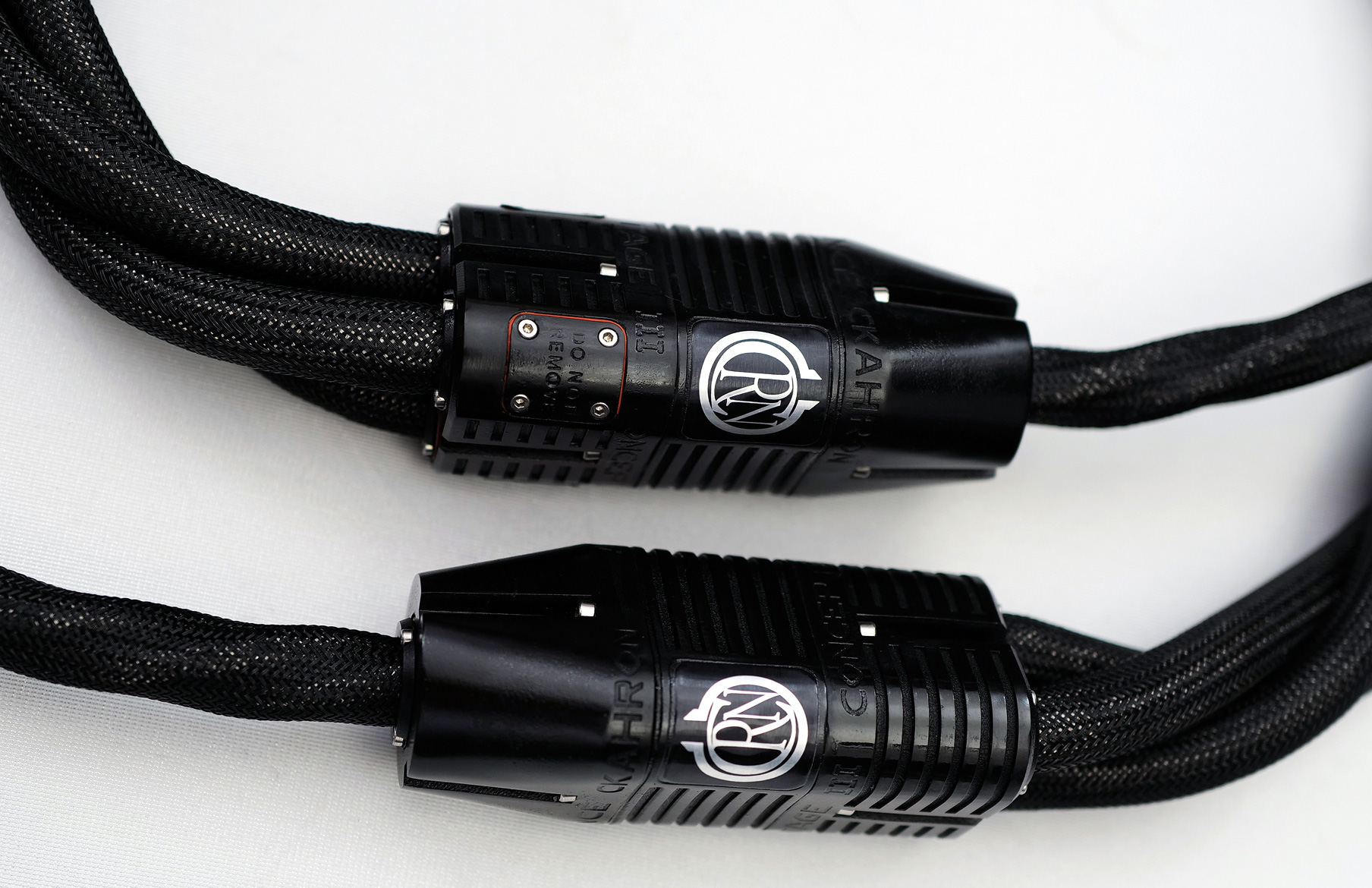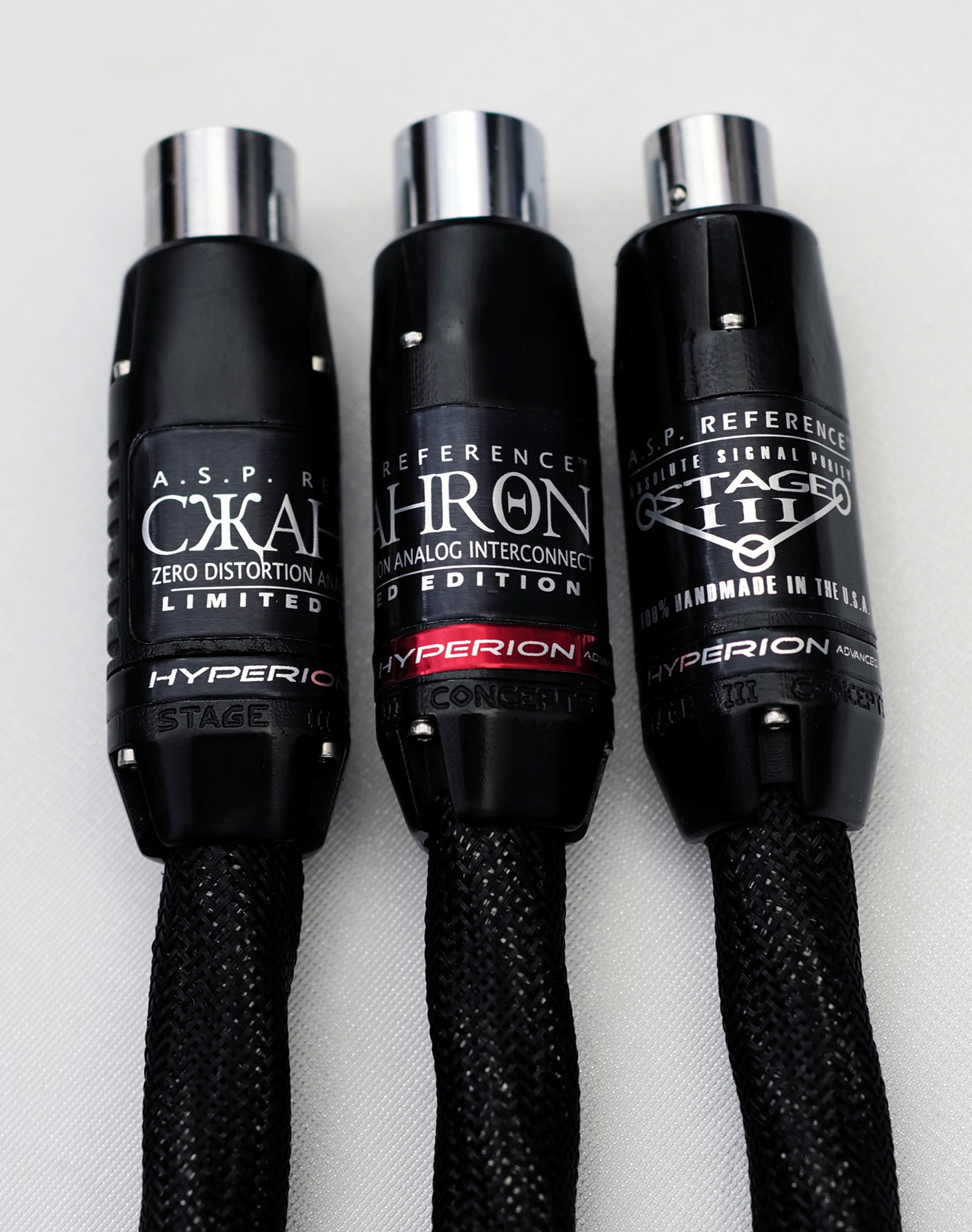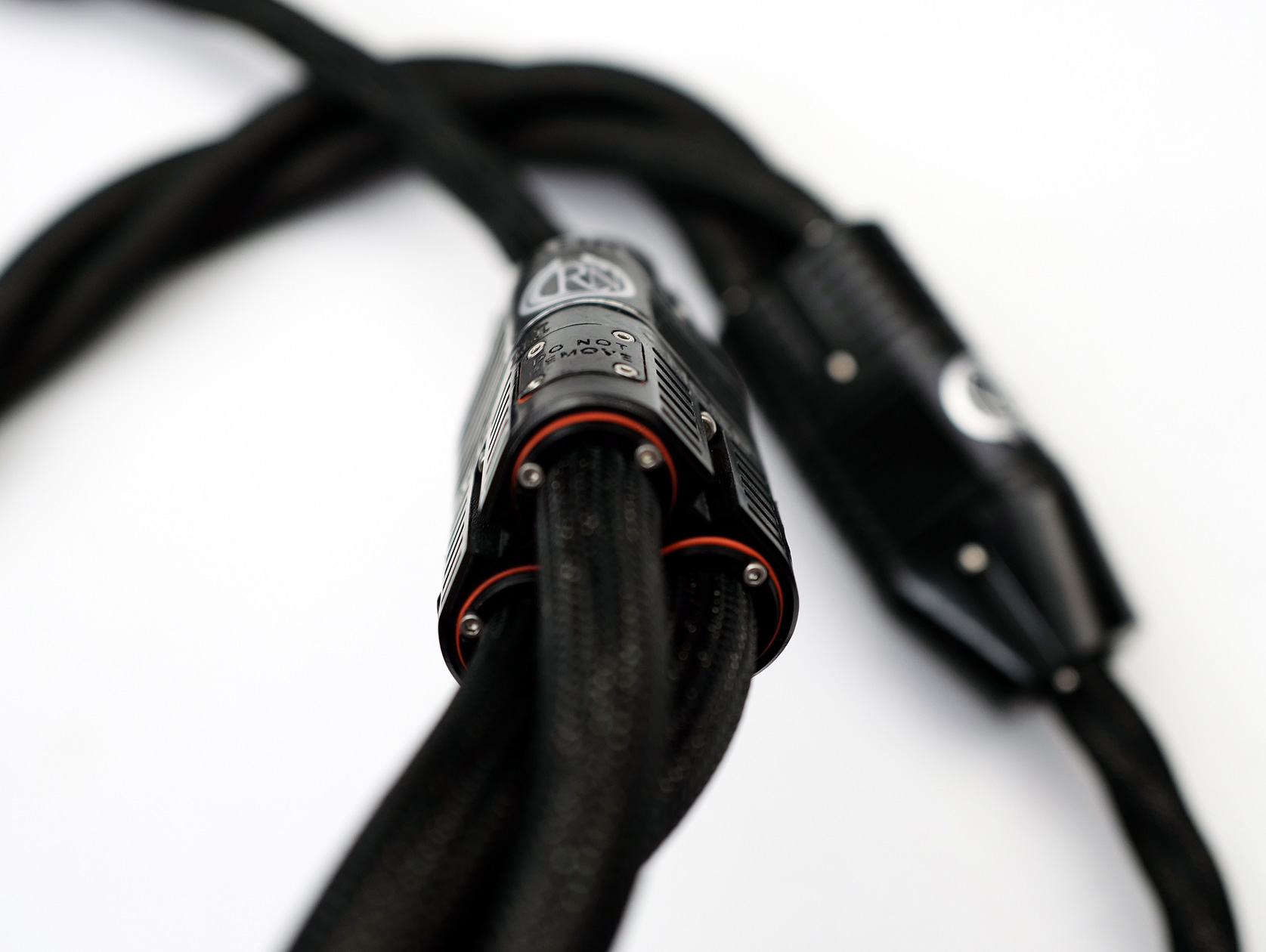I have not seen a more complicated design than the Ckahron, and it is among the heaviest sets I’ve handled with two modules built into each cable, each positioned close to each end. Proper weight support is crucial in mitigating strain exerted on the connectors on both the cable and equipment if the cable is used in a rack system and hangs in midair. Yet, surprisingly in spite of the massive construction, it is among the most flexible and nimble in handling regardless of size. One can therefore deduce that despite the high strand count of the triple dual-helix configuration of the Ckahron, the AeroStrandUltra conductor must be an extremely soft alloy at the very least. This also means the cable allows for a high degree of bending in relative shorter clearances between the wall and the rear panel of equipment.
My analog system is chaired by the Audio Note UK IO Ltd field-coil cartridge system, the companion AN-1S-Sogon six-wire tonearm, the Clearaudio Master Innovation turntable system and the Pass Laboratories Xs Phono phono stage. My digital system begins with the Aurender N-1000SC caching music server and the Bricasti Design M21 DAC, alternating with the Esoteric K-01XD SACD player/USB DAC. Both systems are fed by the PS Audio DirectStream Power Plant 20 AC regenerator. Preamplification common to both is the Pass Labs Xs Preamp, driving the company’s XA200.8 pure class A monoblocks, alternating with a pair of Bricasti Design M28 monoblocks. Speakers are the Sound Lab Majestic 645 electrostatic panels.
My reference cable system is the A.R.T., with its pair of $12,200, 1.8 meters Analyst EVO RCA linking the Xs Phono to the Xs Preamp. The company’s $9,000 1.8 meters Analyst SE XLR links the preamplifier to the monoblocks. The monoblocks drive the panels with a pair of $16,000 Analyst SE speaker cables in spade termination.
With quite a few cables and cable systems having been auditioned in my systems in recent years, the Ckahron XLR, being the flagship of Stage III, theoretically faced the steepest uphill battle in auditioning. The Ckahron needed to show it would at the very minimum be an equal of the Analyst EVO RCA. While it was not an RCA to RCA comparison, the Analyst EVO that I have was in RCA only, and it would be nice to know where the Ckahron stood. Since there were two pairs of the Ckahron XLR at my disposal, I initially installed the shorter, 1.5 meter pair between the DAC and the Xs Preamp, and then switched it to go between the Xs Phono and the Xs Preamp.
Playing the 24 bits 44.1 KHz file of the Barbra Streisand’s Greatest Hits Volume II from HDtracks, the first pair of Ckahron XLR showed me what it means to have the lowest noise coming through; the unadulterated sounds of instruments and voices thus reproduced with the emerging subtleties of tonality and all its complexity of this recording must be experienced before one kicks the bucket.
Then came the Metallica “The Unforgiven,” the Mike Oldfield “Crisis,” then a medley of Donna Summer hits; the bass lines and rhythms of background electric guitars took on solid presence, which breathed fervent life into the music making process. “MacArthur Park,” especially in this remix, qualifies as the most exhilarating disco music, and its beat-perfect break into “Hot Stuff” was sweeping and adrenaline pumping. The two-song mix crowns the dance scenes as Giorgio Moroder’s most effective and memorable. The Stage III helped transform the pop hits audiophile worthy.
With the first pair of Ckahorn XLR staying put and adding the second, longer pair of the Ckahron XLR between the Xs Preamp and the XA200.8 monoblocks, alternating with the Bricasti Design M28 monoblocks, there’s a substantial sense of purity in quietness of noise in the Ckahron’s demeanor. In the rarefied space, music takes on the most palpable presence with the signal path laid out by the cable itself from either the Bricasti Design DAC or the Xs Phono to the Xs Preamp, and onwards to the monoblocks.
Playing the Proprius Cantate Domino LP, the Stage III redefined the experience. In speed, the Stage III was expedient and utterly composed. In dynamics, the contrasts between the choir, the brass and the pipe organ were at its most startling and engaging. In tone, it showed the Stage III XLR was every bit as supremely vivid and uncensored as the A.R.T. RCA. I could at once relax and entrust the Stage III in bringing some of the finest music into my life. It was the first time two pairs of balanced cable in my system were showing me how vast the record was in context and emotions. Though featuring a lone trumpet and a pipe organ, the two pairs of Stage III XLR together conveyed unprecedented effectiveness and persuasiveness of palettes of tonal richness, at same time rendering the performance as tonally harmonious and supremely easy on the ear.
With the Stage III, the melodies were freed of detrimental impurities prevalent in lesser cables, and were thus revealed as the most authentic in recent memory in the unprecedented absence of distortion induced lingering harmonics. The effect permeated so, as if chants of encore and thunderous applause would ruin the bubble that one was tucked into by the time the music concluded. While the music itself is not revolutionary in any way, the cables helped revealed the genius of the recording which reinforced the impression of the LP as the genre’s greatest.
Spinning the JVC XRCD Ondekoza, another recording with a single woodwind and a drum, the Ckahron cast a massive, silent background as per the digital format’s strength, solidifying the lone fue, a Japanese flute, in a decidedly feeble but concrete footprint. The onslaught of the towering taiko drum was rendered cleanly separate and unto a space of its own, enveloping but not usurping the fue’s presence. This is the event that only the finest in cable technology can take on triumphantly. All other cables, except the A.R.T., lost grip and projected the taiko as an incoherent mess while drowning out the fue. The melodies don’t form massive, sweeping structures and yet with the Stage III, the force conveyed is felt at once. If you want it loud, turn it up if your system is free of dynamic compression and you will hear the instruments with stronger realism.
Noise from radio frequency interference and electromagnetic interference along cables are well documented, and the suppression of such noise by technologies of power conditioners and regenerators are increasingly miniaturized and effective. The Stage III Ckahron XLR is among products from the few companies that have the expertise to purge noise in cables to new heights.
A high-quality cable system is like the nervous system of a human body that transmits crucial data of sensory inputs to the brain. But the cost associated with such a cable system is often ridiculed by many, in spite of testimonies from users and reviewers. That is because one’s ability to spend feeds one’s belief system, cable prices being a particular case in point. Some readers might think $20,000 for a pair of cables as unthinkable, but so do many readers on some $100,000 turntable system the next audiophile has. Facts are easy to obtain if you want it; it takes a visit to your local dealership to confirm what expensive cables can do, and the way to get true value in cable purchases is a gradual, systematic approach. Consider the caliber of your system versus that of the cable system. Do you believe your electronics and speakers have outpaced your cable system, that your system has more resolution than the cable system is designed to handle?
System matching is everything in choice of cables. Using a pair of flagship cables in a mid-price system may elevate certain performance parameter, but there is also the prospect of exposing the limitations or weakness of the system, such as the top-end grunt of budget equipment otherwise masked by budget cables, making the system sound worse. One way to tell is by auditioning a variety of cables. When a single pair of balanced interconnects under review is able to reveal more information of the music and presents a performance increase the way the Ckahron does in my system, then the caliber of the cables is very complimentary to that of the system. Audition and see if higher grade cables make your system sound better.
While during auditioning, on the average, one out of ten cable models would interest me enough to stay on for additional observation, the Stage III Concepts A.S.P. Ckahron is the latest one in a long time to compliment the fidelity level of my reference system, thus taking its spot alongside the A.R.T. Things happen when the right conditions converge, and cable companies that possess the energy, finance and technological expertise essential and favorable to the creation of products like the Ckahron are far and few in between. Its existence pushes the boundaries of known methods in creating the highest performing cable systems.
The fact of the matter is it’s not always an easy decision to invest in and recommend products of a one-man operation, especially when the sole proprietor is in his seventies. I would like to know if he’d still be around to service the products for our readers in ten years should the readership buys the products. Stage III Concepts proprietor Luis de la Fuente was born in 1966. He’ll be around for some time.
The next-level in high-performance cable system may yet to be created, but until that day comes, the Stage III Concepts A.S.P. Ckahron Ultimate Statement XLR is the highest performing XLR I’ve experienced.
Many super high-end audiophiles splurge on megabuck systems while the cable system is almost consistently the malnourished. With powerful designs from companies like Stage III Concepts, cable systems are now redefining the status of the mighty.
Review system:
PS Audio DirectStream Power Plant 20 AC regenerator
Acoustic Sciences Corporation TubeTraps
Audio Reference Technology Analysts EVO RCA
Audio Reference Technology Analysts SE interconnects, power cables
Audio Reference Technology Super SE interconnects, power cables
Audio Note IO Ltd field-coil cartridge system
Audio Note UK AN-1S six-wire tonearm for IO Ltd
Clearaudio Master Innovation turntable
Audio Desk Systeme Ultrasonic Vinyl Cleaner
Aurender N-1000SC caching music server/streamer
Bricasti Design M21 DSD DAC
Esoteric K-01XD SACD player
Light Harmonic LightSpeed USB cable
Pass Laboratories Xs Phono
Pass Laboratories Xs Preamp
Pass Laboratories XA200.8 pure class A monoblocks
Bricasti Design M28 class A/AB monoblocks
Sound Lab Majestic 645 electrostatic panels
Copy editor: Dan Rubin
- ← Previous page
- (Page 2 of 2)





I would be interested to get your observations with the addition of Ckahron’s speaker wire to complete the Cryogenicly treated cable set.